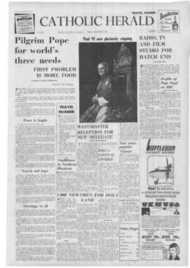Page 8, 27th December 1963
Page 8

Report an error
Noticed an error on this page?If you've noticed an error in this article please click here to report it.
Tags
Share
Related articles
A Vision Of Europe
The Duke Of Alba Says • • •
Italian Cardinal Hails 'the Christian Spain'
Spain 'and Europe
The Reign In Spain
SPAIN Folklore in
the heart of the festival
SPAIN stands at the crossroads of the continents, and not only geographically. In her racial, cultural and artistic aspects, she offers a vast cross-fertilisation of Europe, Africa, the Arab world and Latin America.
Hcr songs and music and poetry are full of a curious amalgam of pathos and renewal, the abandonment of the troubadour, the aspiration of John of the Cross.
All this comes out with special force at the festivals which occur all over Spain from St. Joseph's day to that our Our Lady of the Pillar (October 12).
The early morning celebrations arc religious. high Mass is sung. Whatever the feast, the Spaniard's, special love for Our Lady — thti clement that makes it almost im possible for him to become a com
plete unbeliever — is always strongly marked.
The appropriate statue is carried in procession by the young men, with local dignitaries walking behind,and the girls wearing their regional dress. Later come the games, the dancing, the songs and the music of the locality. And Spain is one of the countries with the richest and most subjective brands of folklore.
Many of the festivals are renowned throughout the world— the Fallas of Valencia with their artistic ninots, the sculptured figures that go up in flames on St. Joseph's night amid a roar of fireworks, until the whole city seems to be on fire; the April Ferias of Seville with the girls riding the fine Andalusian horses while the pavilions shake with the heel-tapping of hailaoras, the clapping of hands and the strumming of guitars.
In the lusty. virile fiesta of Pamplona, the highlight is the encierro, when the young men run through the streets in front of the bulls due to be fought that day, and have to cross the town on the way to the bullring. Wearing boinas, red and blue handkerchiefs, around their necks, white shirt and white trousers, the youngsters move around in teams and dance to the music of the iota of Navarre.
Then there are the Great Week of San Sebastian, the Santander August Festival (both cosmopolitan rather than traditional). and the Murcia festivities which start on Easter Sunday with the Bando de la Huerta, continue with the battle of flowers, and end with the Burial of the Sardine.
Madrid celebrates the feast of its patron. San Isidro, with Goya memories of the San Isidro Meadow. Bilbao and Gijon celebrate the Virgin of August, the feast of Our Lady's Assumption; the Asturias pays court to its patroness. Our Lady of Covadonga, on September 8.
The feast of St. Matthew is the big day at Valladolid and Oviedo —especially at the latter with an explosion of opera in the Campoamor 'Theatre. Barcelona celebrates the feast of Our Lady of Ransom, while the Saragossa Festival is that of Our Lady of the Pillar, October 12. the day when Columbus discovered America.
But to get to the heart of Spanish folklore, you must go to the less famous Festivals in small towns and villages. In Catalonia they dance the pretty sardana and build curious human towers like those of the AiquelA of Valls. Then there arc the Asturian romeria pilgrimages between maize fields overlooking the sea. Fishermen organise a sea procession of Our Lady of Mount Carmel with flower-decked boats escorting the statue.
After the romeria the xujuritrus sound far into the warm summer night and re-echo from the moun tains, as in the Carmel festivals of Cangas de Narcca, of the Carmen of Poli de Siero, the Virgen de la Guia at Llanes, where they dance the thousand-year-old Danza prima and the Regla at Cadavedo. The drink is cider and the game is ninepins.
In the Galician romeria. the hagpipes can be heard, for the Galicians are Celts. In the Castilian villages the gravity of the local character is reflected in the morning processions. As the sun wanes in the late afternoon, however, there is usually a cape fight with heifers. Instead of eider there is red wine. Instead of the bagpipe. there is the town crier's drum.
Everything in Basque Country is unique, and likewise the festivals where you can watch them playing pelota, or the contests of the aizkolaris (wood chopping and weight lifting). the dances of the amarsas and aurrescus, the regattas of the fishing villages and their choir songs.
Corpus Christi is celebrated with unique grandeur in imperial Toledo. Granada and Orotava. But the deep Spanish sense of religion, suffering and death really comes into its own, and takes over from the picturesque gaiety of the rest of the year, in Holy Week.
The best known Holy Week celebrations occur at Seville, but there are equally moving ones at Valladolid, Zamora, and Cuenca. The dramatic passing of the processions, the silence of the crowds. the mysterious slow heat of the drums. the hooded penitentes hearing their torches . . . these are the sights uniting north and south. cast and west, and, if You have never seen them. you will never understand the immensely varying. elusive, tantalising and utterly captivating soul of Spain.
blog comments powered by Disqus













